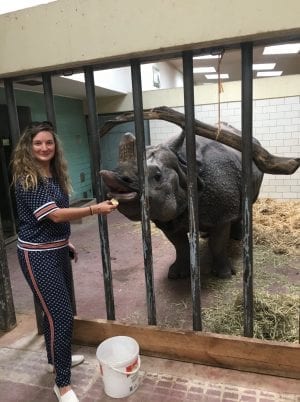
Zoos – the good, the bad and the ugly
Words: Samantha Ward
We’re going to the zoo, zoo, zoo. How about you, you, you…?”
Perhaps you remember singing the song when you were a child. If you do, you probably have it stuck in your head now! If you don’t, I’m sure you remember those fun-filled zoo days watching gigantic elephants spraying themselves with water, nose pressed against the glass looking at exotic snakes, ever tempted to be naughty and tap on the glass to get them to move or, if you were really lucky, getting to pet a rainbow-coloured bird perched on the arm of a zookeeper.
I certainly do.

Nose pressed against the glass. Credit: Author’s own.
So much so that I went on to volunteer at Colchester Zoo in the UK and study Zoology for my undergraduate degree at university. Now, a decade on, I am a member of Zoos Victoria, regularly visiting Melbourne Zoo for weekend escapades. Zoos, in my mind, are magical places that allow us to interact with animals we may never get a chance to see in the wild. Not only that but many zoos invest a huge amount of time and finances into rescuing these animals and ensuring they do not go extinct.
Not on our watch!
I recently attended a riveting talk at the University of Melbourne by Jenny Gray, the CEO of Zoos Victoria, who said the organisation has taken a pledge that no Victorian terrestrial vertebrate species would go extinct on their watch. Zoos Victoria is a ‘not-for-profit zoo-based conservation organisation’, encompassing Healesville Sanctuary, Melbourne Zoo, and Werribee Open Range Zoo, with all revenue going directly to fighting extinction. Their conservation programs can be found here. This is a fantastic feat, but unfortunately not all zoos can be credited with the same outlook and goals. Furthermore, zoos as we know them are relatively new and have evolved from something that, in the modern world, may be viewed as cruel and inhumane.

Example of an old animal enclosure at Melbourne Zoo. Credit: Author’s own.
Exploration, establishment and empathy
Humans have always been fascinated by wild animals. As far back as 6000-7000 years ago there were reports that people kept wild animals in Egypt and China. During the 16th century, people began to travel the globe by ship, colonising the Americas and other continents. European explorers would return after collecting and storing exotic animals on board their ships to trade or gift them in their home countries. The very first zoos were effectively small animal collections and were privately owned; often by royalty. Public interest, however, grew and circuses, ticketed menageries, and animal parades were established. One such menagerie was the Tiergarten Schönbrunn in Vienna, Austria, which I had the pleasure of visiting a few years ago. This zoo was originally created in the mid 18th century as a menagerie for the Schönbrunn Palace but was made available to the public in 1765.

An inhabitant of Tiergarten Schönbrunn. Credit: Author’s own.
In the 19th century, staffed zoological gardens began to establish, with the London Zoological Gardens opening in 1820s, with the term ‘zoo’ first being used a couple of decades later. This was followed by zoos around Europe, and in the US in 1860s with the creation of the first zoo in Philadelphia.
Animals were kept in cages, prodded to see how they reacted, and even challenged to fight one another to test their strength. The general public were curious about these strange beasts. Over time though, this curiosity began to branch, and collections moved from solely entertainment purposes to becoming places of scientific study and public education. Once people began to realize that animals, like humans, feel pain, fear and empathy, the way in which these animals were displayed at zoos evolved. At the earliest zoos, animals were kept in cages to display them to visitors rather like actors on a theatre stage. Later, however, these enclosures morphed into areas designed primarily to suit the needs of a particular animal.

In the aviary at Melbourne Zoo. Credit: Author’s own.
Enriching our lives
Zoo enrichment programs were developed to encourage natural behaviour in captive animals. Keepers began to suspend food from trees and pull food along ziplines to encourage jumping and hunting behaviours, create food puzzles for animals to solve, and create areas completely obscured from the visitors’ view for animals to retreat. If you’re interested in learning more about the evolution of zoos and the ethics involved, I’d thoroughly recommend Jenny Gray’s book entitled ‘Zoo Ethics: The Challenges of Compassionate Conservation’.

Food enrichment is important within zoos. Credit: Author’s own.
So, should you continue to visit zoos and wonder at their inhabitants?
As a strong advocate for zoos such as those run under the Zoos Victoria banner, that are primarily research and conservation organisations, my personal opinion is yes. But, ultimately, it’s up to you. One aspect to bear in mind is that although there are reportedly over 10,000 zoos in existence around the world, many are not recognised by the World Association of Zoos and Aquariums (WAZA)and its affiliates as of a suitable quality. Although codes have been put in place by WAZA to ensure zoos meet a particular standard of ethics, many ‘animal sanctuaries’, ‘zoos’, ‘wildlife parks’, ‘animalariums’ etc can fly under the radar. My advice would be to research an institution, particularly in a country where zoo standards may differ from those you are used to, before handing over money for an entry ticket which could ultimately support inhumane treatment of the animals you’re there to see.

It’s a tough life! Credit: Author’s own.
I will leave you with the words of Mahatma Gandhi who said, “The greatness of a nation and its moral progress can be judged by the way its animals are treated”.